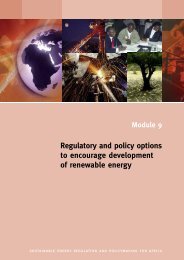Increasing access to energy services in rural areas - REEEP ...
Increasing access to energy services in rural areas - REEEP ...
Increasing access to energy services in rural areas - REEEP ...
You also want an ePaper? Increase the reach of your titles
YUMPU automatically turns print PDFs into web optimized ePapers that Google loves.
MODULE 10: INCREASING ACCESS TO ENERGY SERVICES IN RURAL AREAS<br />
page 10.13<br />
5. LINKAGE OF ENERGY TO THE MDGs<br />
Many <strong>in</strong>stitutions have considered the MDGs and <strong>in</strong>tegrated the important l<strong>in</strong>kages<br />
of <strong>energy</strong> <strong>services</strong> <strong>to</strong> them. In fact, as <strong>energy</strong> <strong>services</strong> are essential <strong>in</strong>gredients<br />
of all three pillars of susta<strong>in</strong>able development (economic, social and<br />
environmental, as below), they can be an <strong>in</strong>put <strong>to</strong> all MDGs:<br />
• Economic susta<strong>in</strong>ability assumes that social and environmental aspects of susta<strong>in</strong>able<br />
development must be def<strong>in</strong>ed economically;<br />
• Social susta<strong>in</strong>ability assumes that economic and environmental aspects must<br />
be def<strong>in</strong>ed by tak<strong>in</strong>g <strong>in</strong><strong>to</strong> account social considerations (i.e. equal opportunities<br />
for all);<br />
• Environmental susta<strong>in</strong>ability assumes that the economic and social aspects<br />
are def<strong>in</strong>ed by consider<strong>in</strong>g environmental constra<strong>in</strong>ts;<br />
• The long-term perspective assumes social, economic and environmental<br />
aspects can be susta<strong>in</strong>ed through generations and views rema<strong>in</strong> consistent<br />
with the majority of the population. 26<br />
5.1. Development agencies<br />
A number of development agencies are help<strong>in</strong>g <strong>to</strong> facilitate the MDGs, not so much<br />
through direct <strong>in</strong>volvement <strong>in</strong> their management, as <strong>in</strong> the f<strong>in</strong>anc<strong>in</strong>g of market<br />
studies and the development of bus<strong>in</strong>ess plans <strong>to</strong> assist private sec<strong>to</strong>r <strong>in</strong>terests<br />
<strong>in</strong> establish<strong>in</strong>g and operat<strong>in</strong>g <strong>energy</strong> <strong>services</strong> for <strong>rural</strong> people. These efforts are<br />
aimed at address<strong>in</strong>g uncerta<strong>in</strong>ty and provid<strong>in</strong>g the necessary <strong>in</strong>terface between<br />
poor communities, <strong>energy</strong> <strong>services</strong> and private capital.<br />
Department for International Development – UK<br />
The UK’s Department for International Development’s (DFID) document “Energy<br />
for the Poor” clearly outl<strong>in</strong>es a matrix of <strong>energy</strong> and the MDGs, draw<strong>in</strong>g on case<br />
studies <strong>to</strong> re<strong>in</strong>force the l<strong>in</strong>kages. 27 Broadly this shows that:<br />
• To halve extreme poverty – <strong>access</strong> <strong>to</strong> <strong>energy</strong> <strong>services</strong> facilitates economic<br />
development – micro-enterprise, livelihood activities beyond daylight hours,<br />
26<br />
SOPAC/ICCEPT Pacific Islands Biomass Energy Resource Assessment Tra<strong>in</strong><strong>in</strong>g Course<br />
27<br />
DFID – Energy for the Poor, Annex 1










